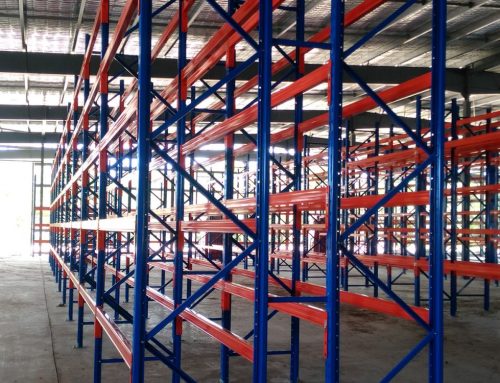We’d define pallet racking as the process of placing goods on pallets. Whether manually or automatically (performed using a palletizer), it plays a key role in the latter stages of the logistics process.
Do you want to warehouse a wide variety of goods on pallets?
Pallet racking’s designed for you. Providing free and direct access to each pallet stored and built to the highest Pallet Racking Safety requirements, our pallet racking offers the best solution for warehouses with varying configurations and requirements. The high flexibility of these shelving allows ultra-personalized studies.
Pallet Racking Advantages:
- Easier access to all items
- Better control of the state of the warehouse
- Optimum adaptability to the storage space and the weight and size of the goods
- Flexible and economical storage of diverse goods on a single rack
- Makes possible direct order preparation
Typical Pallet Rack configurations
AS4084:2012 Safety regulations enable three large warehouse configurations: wide aisles, standard and narrow aisles.
Warehouse with wide aisles
The most common racking configuration is the wide aisle warehouse. This configuration allows for the widest choice of trolleys for serving shelving: front end, reach trucks or order pickers. The lower levels can even be easily served by simple electric pallet trucks or stackers.
- An economically advantageous solution
- Simple service cart with standard shopping and storage trolleys
- Possibility of preparing manual commands at ground level
Structure of a Pallet Rack
For Pallet Racking Safety, structure consists of uprights (or “ladders”) and sleepers. Each ladder is securely fastened to the ground with anchor bolts. The sleepers are then hooked to the frame formed by the ladders. The type and thickness of the profiles selected vary according to the maximum load expected.
Naturally, these specifications also incorporate the applicable standards at the installation site in conjunction with the AS4084:2012 pallet rack security specification.
A choice of optional accessories also ensures safety adapted to each situation and optimum flexibility. For example, anti-collision protection on the uprights and anti-drop bottom bars ensure maximum safety in everyday life. Various specialized equipment further increases the flexibility of use of pallet racking.
Components of a Pallet Rack
Shelving ladders
The basic structure of a shelving ladder consists of two vertical uprights, themselves stabilized by horizontal and diagonal bars. The ladders are assembled and fixed by bolts. To minimize transportation costs, assembly is done on site.
Spacers
Spacers connect each pair of rows of shelves, keeping them at a fixed distance from each other. For shelving equipped with fire protection systems, the spacers are also used for fixing pressure pipes serving sprinkler nozzles.
The gap between the rows of shelves is dictated by site-specific standards and regulations (eg the Pallet Racking Safety in Australia, AS4084:2012). Thus, for euro pallets without overflow, the standard deviation is 200 mm. This gap can be adapted to particular needs – eg. when installing a fire protection system or for pallets with overflowing loads.
Protection of the feet of ladders
Different options exist to protect scales of possible damage. Two types of protection must be distinguished: those covering the front end of each row and those to be installed inside the working aisles.
Protection of the ends of ladders at the entrance of the aisle
The minimum protection required is the installation of a corner angle at each driveway entrance. In Australia, for example, AS4084:2012 Pallet Racking Safety regulations require protection of a height of at least 300 mm, fixed to the floor independently of the rack. An alternative to this corner protection consists of a front bar protecting all the amounts of the shelving. This bar is mounted on the front faces of the ladders and continues along the entire depth of each aisle.
Pallet Racking Safety generally favors steel because this material is more stable. The advantage of wood is still its easy replacement in case of damage.
If all the right conditions are not met, unexperienced palletizing companies can cause damage to your goods in the following ways:
- Unstable stack of goods
Stacking goods can prove to be a real game of Tetris! Everyone’s needs vary from one company to another. For the pallet does not suffer any damage during transport or handling, try to take these factors into account:
It is important to place heavy items at the bottom of your palette and lighter items on top. This way your palette will be more stable and light goods do not crush the heaviest goods.
The size of your boxes is also a factor that can affect the stability of your palette: avoid empty spaces between your boxes.
- Poor Fixing Cargo
Your goods are they set correctly? To guard against possible damage, we recommend using the following:
- The release paper on the bottom of the pallet and between each level of goods.
- Angles and straps around your palette.
- Stretch film or shrink-wrapped to wrap around the whole pallet.
- Poor protection against environmental conditions
The environment is a key factor not to be overlooked when palletizing. Remember that external agents such as dust or moisture can harm your palletized goods.
To prevent these external factors from having a destructive impact on your goods, we strongly recommend you have a qualified service inspect your pallets




